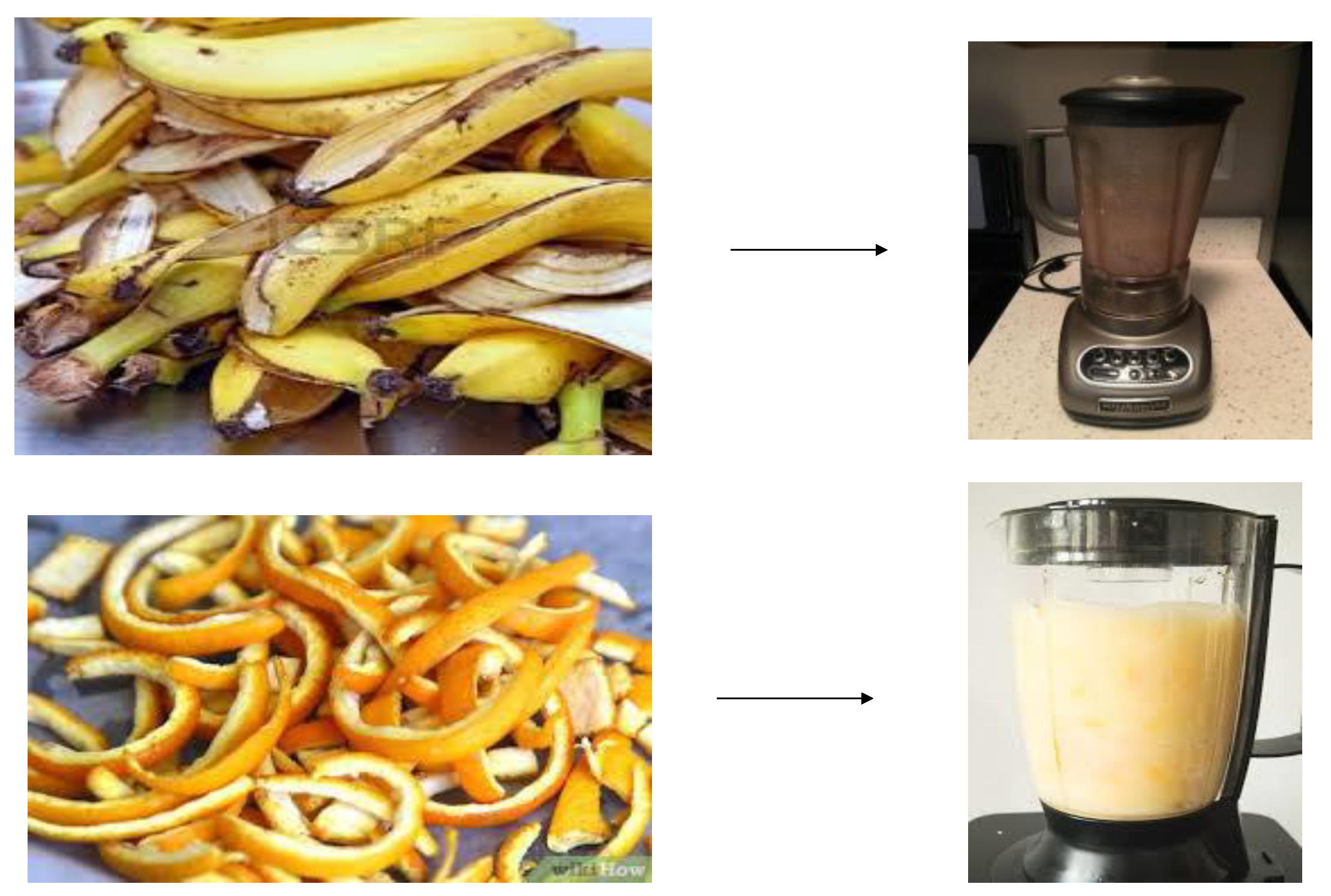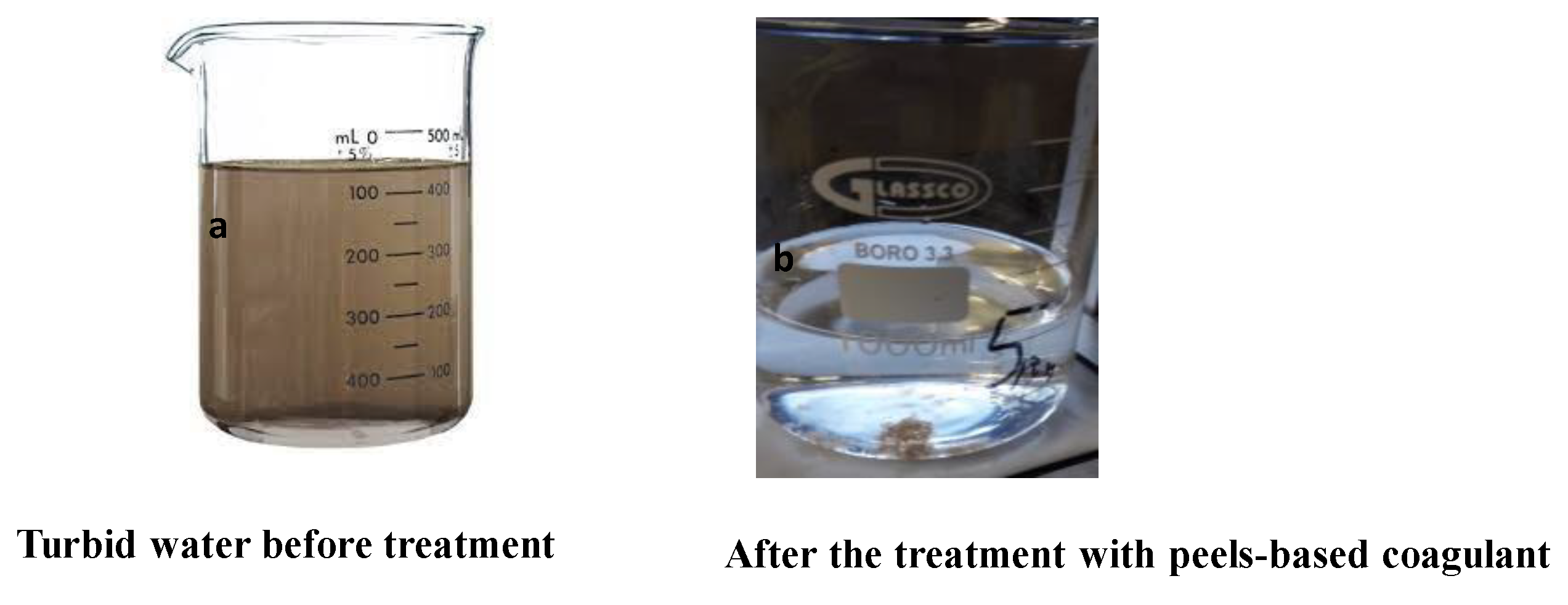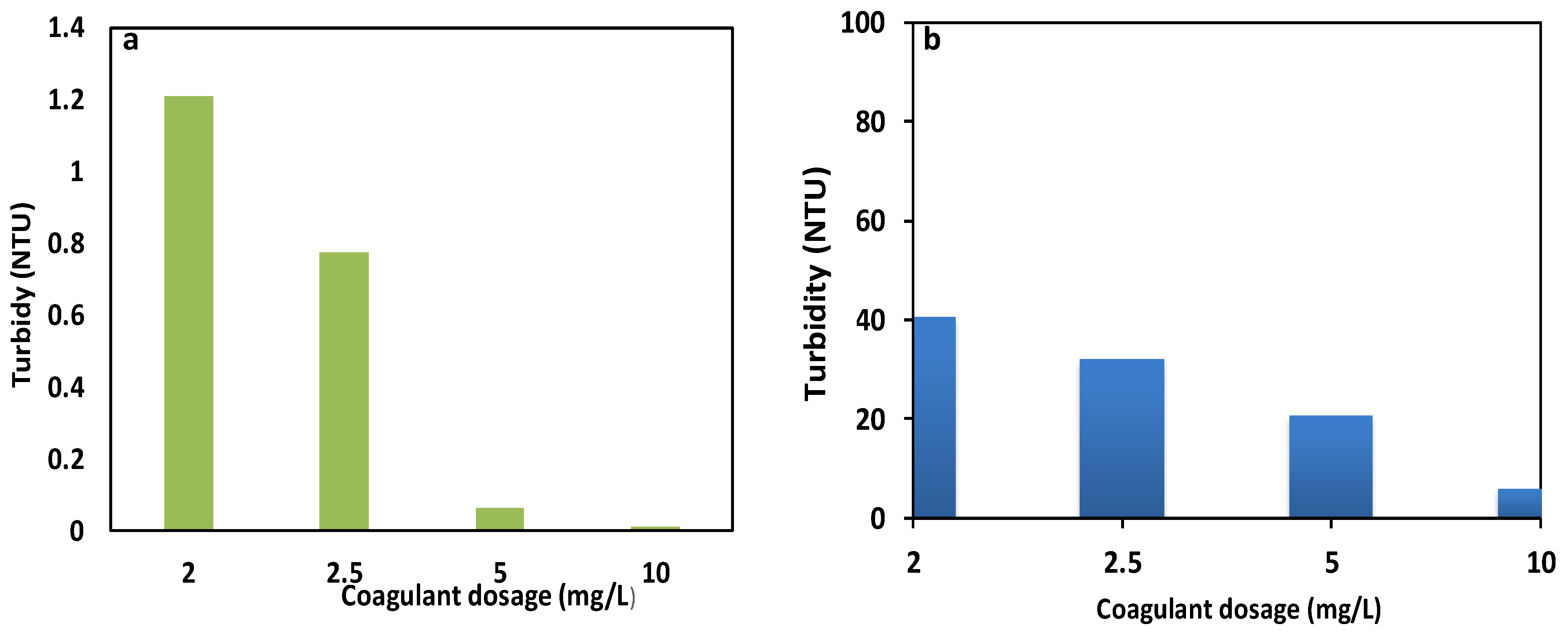Harnessing Project-Based Learning to Enhance STEM Students’ Critical Thinking Skills Using Water Treatment Activity
Abstract
1. Introduction
1.1. Project-Based Learning
1.2. Development of Critical Thinking Skills in STEM Education
1.3. Theoretical Framework
1.4. Purpose of the Study
1.5. Research Design and Methodology
1.5.1. Selection of Participants
1.5.2. Design and Teaching of a Lesson Based on Water Treatment Activities
2. Data Collection and Analysis
Laboratory Experimental Procedure
3. Findings
- The water treatment activity was challenging and encouraged us to apply our minds to find solutions to water problems. The activity required the application of interdisciplinary scientific knowledge to develop sustainable solutions for water problems.
- The complexity of prevailing water problems requires a clear understanding of water treatment techniques. Water is a precious resource and there is a need for us STEM students to be adequately trained in water treatment techniques to ensure that safe and drinkable water can be provided to communities on a sustainable basis.
4. Discussion
5. Conclusions
Author Contributions
Funding
Institutional Review Board Statement
Informed Consent Statement
Data Availability Statement
Acknowledgments
Conflicts of Interest
References
- Owens, D.C.; Petitt, D.N.; Lally, D.; Forbes, C.T. Cultivating water literacy in STEM education: Undergraduates’ socio-scientific reasoning about socio-hydrologic issues. Water 2020, 12, 2857. [Google Scholar] [CrossRef]
- Bybee, R.W. The Case for STEM Education: Challenges and Opportunities; NSTA press: Arlington, VA, USA, 2013. [Google Scholar]
- Boss, S.; Krauss, J. Reinventing Project-Based Learning: Your Field Guide to Real-World Projects in the Digital Age; International Society for Technology in Education: Eugene, OR, USA, 2022. [Google Scholar]
- Krajewski, J.; Grossman, S.; Wright, E.; Hernandez, D. The” Water You Talking About” Model: Engaging High School Students in STEM and Science Communication. Waterline 2019. Available online: https://theieca.org/sites/default/files/COCE2019/program/s207.html (accessed on 3 October 2022).
- Clayton, J.; Terry, L.; Baroni, C.; Velez, M.; Clement, P.; Wu, F.; Tsai, F.; Easson, G.; Banadaki, Y. Advancing STEM Education by Promoting Water Literacy in K-12 Education. In Proceedings of the AGU Fall Meeting Abstracts, New Orleans, LA, USA, 13–17 December 2021; p. ED45H-0781. [Google Scholar]
- Duke, N.K.; Halvorsen, A.-L.; Strachan, S.L. Project-based learning not just for STEM anymore. Phi Delta Kappan 2016, 98, 14–19. [Google Scholar] [CrossRef]
- Donovan, B.M.; Moreno Mateos, D.; Osborne, J.F.; Bisaccio, D.J. Revising the economic imperative for US STEM education. PLoS Biol. 2014, 12, e1001760. [Google Scholar] [CrossRef] [PubMed]
- Connors-Kellgren, A.; Parker, C.E.; Blustein, D.L.; Barnett, M. Innovations and Challenges in Project-Based STEM Education: Lessons from ITEST. J. Sci. Educ. Technol. 2016, 25, 825–832. [Google Scholar] [CrossRef]
- Nguyen, T.P.L.; Nguyen, T.H.; Tran, T.K. STEM education in secondary schools: Teachers’ perspective towards sustainable development. Sustainabilty 2020, 12, 8865. [Google Scholar] [CrossRef]
- Nkalane, A.; Oyewo, O.A.; Leswifi, T.; Onyango, M.S. Application of coagulant obtained through charge reversal of sawdust-derived cellulose nanocrystals in the enhancement of water turbidity removal. Mater. Res. Express 2019, 6, 105060. [Google Scholar] [CrossRef]
- Precious Sibiya, N.; Rathilal, S.; Kweinor Tetteh, E. Coagulation Treatment of Wastewater: Kinetics and Natural Coagulant Evaluation. Molecules 2021, 26, 698. [Google Scholar] [CrossRef]
- Mordeno, I.C.; Sabac, A.M.; Roullo, A.J.; Bendong, H.D.; Buan, A.; Yuenyong, C. Developing the Garbage Problem in Iligan City STEM Education Lesson Through Team Teaching. J. Phys. Conf. Ser. 2019, 1340, 012046. [Google Scholar] [CrossRef]
- Lee, S.M.; Ruwicha, S. Understanding the Basics of STEM Education through Zero Waste Project; IISRR-IJR: West Bengal, India, 2017. [Google Scholar]
- Fleming, D.S. A Teacher’s Guide to Project-Based Learning; ERIC: Blue Ridge Summit, PA, USA, 2000. [Google Scholar]
- Mergendoller, J.R.; Thomas, J.W. Managing project based learning: Principles from the field. Retrieved June 2005, 14, 2005. [Google Scholar]
- García González, M.; Veiga Díaz, M.T. Guided Inquiry and Project-Based Learning in the field of specialised translation: A description of two learning experiences. Perspectives 2015, 23, 107–123. [Google Scholar] [CrossRef]
- Helle, L.; Tynjälä, P.; Olkinuora, E. Project-based learning in post-secondary education–theory, practice and rubber sling shots. High. Educ. 2006, 51, 287–314. [Google Scholar] [CrossRef]
- Almulla, M.A. The Effectiveness of the Project-Based Learning (PBL) Approach as a Way to Engage Students in Learning. Sage Open 2020, 10, 2158244020938702. [Google Scholar] [CrossRef]
- Keegan, A.; Turner, J.R. Quantity versus quality in project-based learning practices. Manag. Learn. 2001, 32, 77–98. [Google Scholar] [CrossRef]
- Ardianti, S.; Sulisworo, D.; Pramudya, Y.; Raharjo, W. The impact of the use of STEM education approach on the blended learning to improve student’s critical thinking skills. Univers. J. Educ. Res. 2020, 8, 24–32. [Google Scholar] [CrossRef]
- Hacioğlu, Y.; Gülhan, F. The effects of STEM education on the students’ critical thinking skills and STEM perceptions. J. Educ. Sci. Environ. Health 2021, 7, 139–155. [Google Scholar] [CrossRef]
- Mutakinati, L.; Anwari, I.; Kumano, Y. Analysis of Students’ Critical Thinking Skill of Middle School through STEM Education Project-Based Learning. J. Pendidik. IPA Indones. 2018, 7, 54–65. [Google Scholar] [CrossRef]
- Priatna, N.; Lorenzia, S.; Widodo, S.A. STEM education at junior high school mathematics course for improving the mathematical critical thinking skills. J. Educ. Gift. Young Sci. 2020, 8, 1173–1184. [Google Scholar] [CrossRef]
- Hafni, R.; Herman, T.; Nurlaelah, E.; Mustikasari, L. The importance of science, technology, engineering, and mathematics (STEM) education to enhance students’ critical thinking skill in facing the industry 4.0. J. Phys. Conf. Ser. 2020, 1521, 042040. [Google Scholar] [CrossRef]
- Hamdu, G.; Fuadi, F.; Yulianto, A.; Akhirani, Y. Items quality analysis using rasch model to measure elementary school students’ critical thinking skill on stem learning. J. Pendidik. Indones. 2020, 9, 61–74. [Google Scholar] [CrossRef]
- Stoller, F.L.; Myers, C.C. Project-based learning: A five-stage framework to guide language teachers. In Project-Based Learning in Second Language Acquisition; Routledge: London, UK, 2019; pp. 25–47. [Google Scholar]
- Du, X.; Han, J. A literature review on the definition and process of Project-Based Learning and other relative studies. Creat. Educ. 2016, 7, 1079–1083. [Google Scholar] [CrossRef]
- Barak, M.; Dori, Y. Enhancing undergraduate students’ chemistry understanding through project-based learning in an IT environment. Sci. Educ. 2005, 89, 117–139. [Google Scholar] [CrossRef]
- Chatwattana, P.; Nilsook, P. A Web-based learning system using project-based learning and imagineering. Int. J. Emerg. Technol. Learn. 2017, 12, 4–22. [Google Scholar] [CrossRef][Green Version]
- Leykum, L.K.; Pugh, J.A.; Lanham, H.J.; Harmon, J.; McDaniel, R.R. Implementation research design: Integrating participatory action research into randomized controlled trials. Implement. Sci. 2009, 4, 1–8. [Google Scholar] [CrossRef] [PubMed]
- Swann, C.J. Action research and the practice of design. Des. Issues 2002, 18, 49–61. [Google Scholar] [CrossRef]
- Johnson, J.; Macalalag, A.Z.; Dunphy, J. Incorporating socioscientific issues into a STEM education course: Exploring teacher use of argumentation in SSI and plans for classroom implementation. Discip. Interdiscip. Sci. Educ. Res. 2020, 2, 1–12. [Google Scholar] [CrossRef]
- Urválková, E.S.; Surynková, P. Sustainable development indicators—Untapped tools for sustainability and STEM education: An analysis of a popular Czech educational website. Sustainability 2021, 14, 121. [Google Scholar] [CrossRef]
- Kertil, M.; Gurel, C. Mathematical modeling: A bridge to STEM education. Int. J. Educ. Math. Sci. Technol. 2016, 4, 44–55. [Google Scholar] [CrossRef]
- Oyewo, O.A.; Mutesse, B.; Leswifi, T.Y.; Onyango, M.S. Highly efficient removal of nickel and cadmium from water using sawdust-derived cellulose nanocrystals. J. Environ. Chem. Eng. 2019, 7, 103251. [Google Scholar] [CrossRef]
- Gaya, M.; Zango, M.; Yusuf, L.; Mustapha, M.; Muhammad, B.; Sani, A.; Tijjani, A.; Wahab, N.; Khairi, M. Estimation of turbidity in water treatment plant using Hammerstein-Wiener and neural network technique. Indones. J. Electr. Eng. Comput. Sci. 2017, 5, 666–672. [Google Scholar] [CrossRef]
- Singanusong, R.; Tochampa, W.; Kongbangkerd, T.; Sodchit, C. Extraction and Properties of Cellulose from Banana Peels. Int. J. Chem. Biomol. Metall. Mater. Sci. Eng. 2014, 21, 201–213. [Google Scholar] [CrossRef]
- Kamsonlian, S.; Suresh, S.; Majumder, C.; Chand, S. Characterization of banana and orange peels: Biosorption mechanism. Int. J. Sci. Technol. Manag. 2011, 2, 1–7. [Google Scholar]
- Nkurunziza, T.; Nduwayezu, J.; Banadda, E.; Nhapi, I. The effect of turbidity levels and Moringa oleifera concentration on the effectiveness of coagulation in water treatment. Water Sci. Technol. 2009, 59, 1551–1558. [Google Scholar] [CrossRef] [PubMed]
- Asrafuzzaman, M.; Fakhruddin, A.; Hossain, M. Reduction of turbidity of water using locally available natural coagulants. Int. Sch. Res. Not. 2011, 2011. [Google Scholar] [CrossRef]
- Xia, X.; Lan, S.; Li, X.; Xie, Y.; Liang, Y.; Yan, P.; Chen, Z.; Xing, Y. Characterization and coagulation-flocculation performance of a composite flocculant in high-turbidity drinking water treatment. Chemosphere 2018, 206, 701–708. [Google Scholar] [CrossRef]
- Yamin, Y.; Permanasari, A.; Redjeki, S.; Sopandi, W. Implementing project-based learning to enhance creative thinking skills on water pollution topic. J. Pendidik. Biol. Indones. 2020, 6, 225–232. [Google Scholar] [CrossRef]
- Ridlo, Z.R.; Nuha, U.; Terra, I.W.A.; Afafa, L. The implementation of project-based learning in STEM activity (water filtration system) in improving creative thinking skill. Proc. J. Phys. Conf. Ser. 2020, 1563, 012073. [Google Scholar] [CrossRef]
- Fadiawati, N.; Diawati, C.; Syamsuri, M. Using problem-based learning to improve students’critical thinking skills to deal hoax information in chemistry. Periódico Tchê Química 2020, 17, 120–134. [Google Scholar] [CrossRef]
- Alsarayreh, R. The Effect of Problem-Based Learning Strategy on Developing Critical Thinking Skills. Ilkogr. Online 2021, 20, 623. [Google Scholar]
- Ndlovu, M.S.; Demlie, M. Assessment of Meteorological Drought and Wet Conditions Using Two Drought Indices Across KwaZulu-Natal Province, South Africa. Atmosphere 2020, 11, 623. [Google Scholar] [CrossRef]
- Wanda, E.M.; Mamba, B.B.; Msagati, T.A. Determination of the water quality index ratings of water in the Mpumalanga and North West provinces, South Africa. Phys. Chem. Earth Parts A/B/C 2016, 92, 70–78. [Google Scholar] [CrossRef]




| Stage | Activity |
|---|---|
| 1. Identification of water issue |
|
| |
| |
| 2. Possible solution through PBL | Students and teachers discuss:
|
| 3. Classification of STEM-related subjects | Chemistry/Science (2 h)
|
Technology/Engineering
| |
Mathematics
|
Publisher’s Note: MDPI stays neutral with regard to jurisdictional claims in published maps and institutional affiliations. |
© 2022 by the authors. Licensee MDPI, Basel, Switzerland. This article is an open access article distributed under the terms and conditions of the Creative Commons Attribution (CC BY) license (https://creativecommons.org/licenses/by/4.0/).
Share and Cite
Oyewo, O.A.; Ramaila, S.; Mavuru, L. Harnessing Project-Based Learning to Enhance STEM Students’ Critical Thinking Skills Using Water Treatment Activity. Educ. Sci. 2022, 12, 780. https://doi.org/10.3390/educsci12110780
Oyewo OA, Ramaila S, Mavuru L. Harnessing Project-Based Learning to Enhance STEM Students’ Critical Thinking Skills Using Water Treatment Activity. Education Sciences. 2022; 12(11):780. https://doi.org/10.3390/educsci12110780
Chicago/Turabian StyleOyewo, Opeyemi A., Sam Ramaila, and Lydia Mavuru. 2022. "Harnessing Project-Based Learning to Enhance STEM Students’ Critical Thinking Skills Using Water Treatment Activity" Education Sciences 12, no. 11: 780. https://doi.org/10.3390/educsci12110780
APA StyleOyewo, O. A., Ramaila, S., & Mavuru, L. (2022). Harnessing Project-Based Learning to Enhance STEM Students’ Critical Thinking Skills Using Water Treatment Activity. Education Sciences, 12(11), 780. https://doi.org/10.3390/educsci12110780






